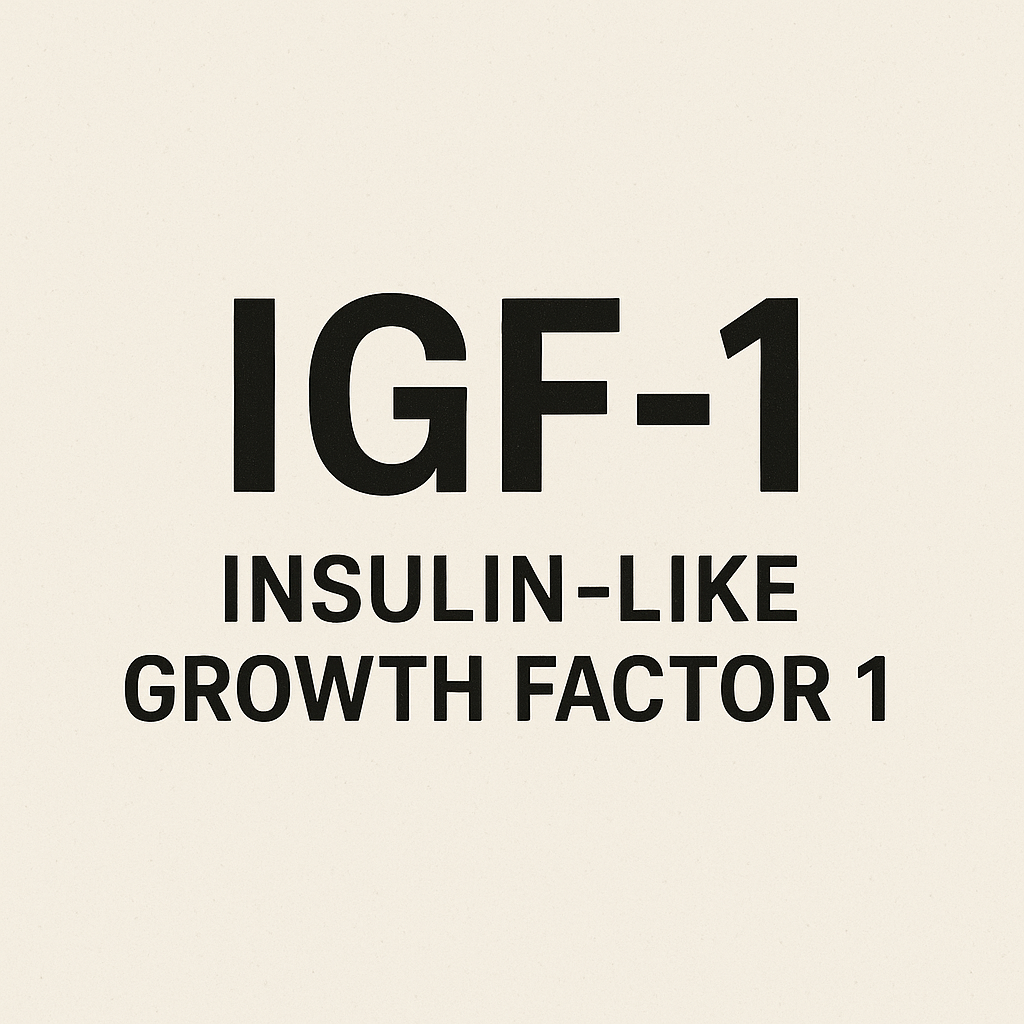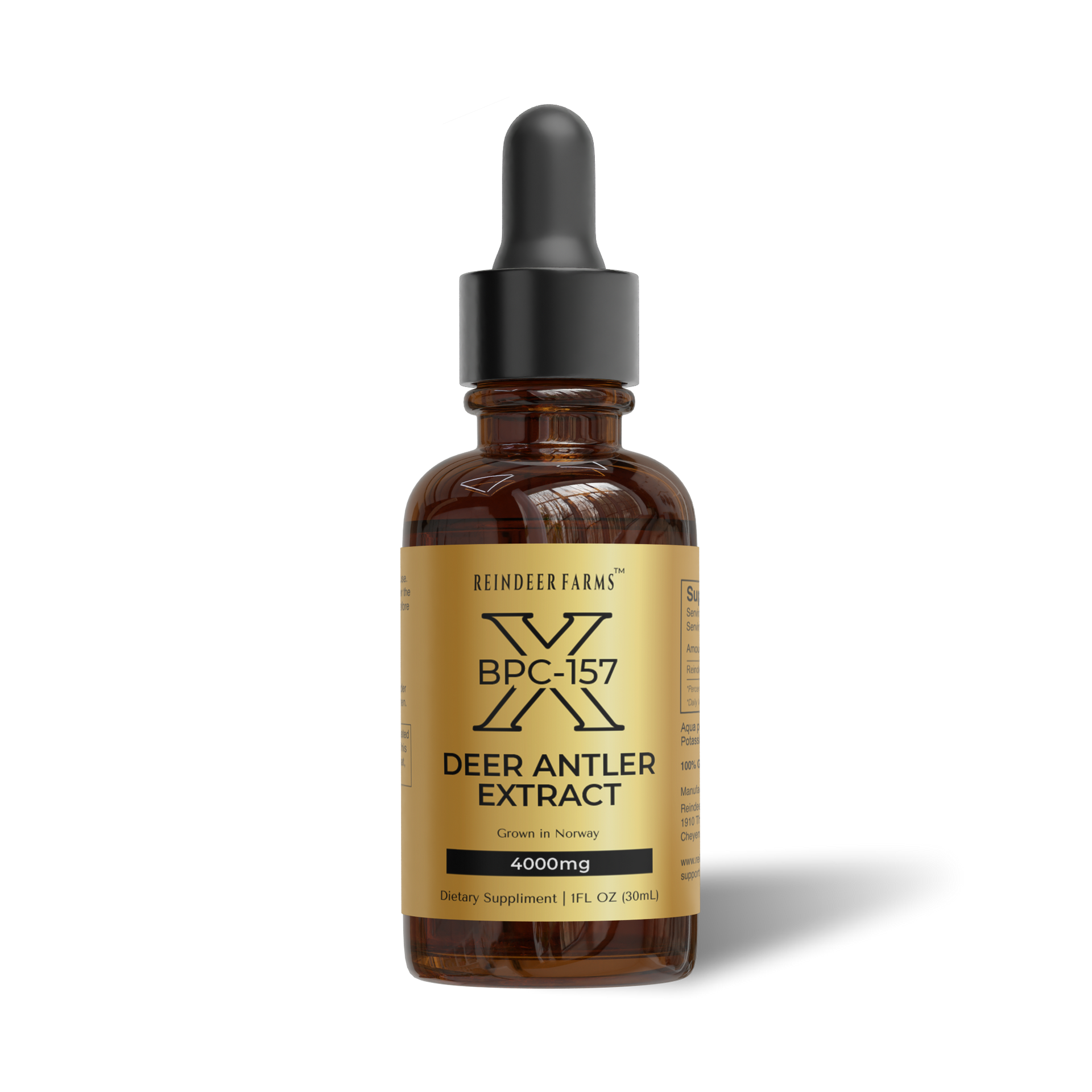
Insulin-like Growth Factor 1 (IGF-1) has garnered significant attention in the health and fitness community, particularly among men seeking to optimize their physical performance and overall well-being. As a mediator of growth hormone activity, IGF-1 plays roles in cellular growth, metabolism, and tissue repair throughout the body. Whether you're an athlete looking to enhance recovery, a fitness enthusiast aiming to maximize muscle growth, or simply someone interested in maintaining optimal health as you age, understanding IGF-1 may be valuable knowledge.
This guide explores the science behind IGF-1, examining its physiological functions, the current state of research on potential benefits, and various options for supporting natural IGF-1 levels. We'll distinguish between prescribed synthetic IGF-1 (a medication) and dietary approaches that may support natural IGF-1 production, evaluate the preliminary evidence behind their efficacy, and provide practical recommendations for those interested in learning more about IGF-1.
Understanding IGF-1: The Growth Hormone Mediator
What is IGF-1?
IGF-1 (Insulin-like Growth Factor 1) is a hormone structurally similar to insulin that plays a role in growth and anabolic processes throughout the body. Produced primarily in the liver in response to growth hormone (GH) stimulation, IGF-1 acts as the key mediator of growth hormone's effects on tissues. Unlike growth hormone, which is released in pulses throughout the day (particularly during sleep), IGF-1 levels remain relatively stable in the bloodstream, providing a more constant anabolic signal to cells.
At the cellular level, IGF-1 binds to specific receptors on cell membranes, initiating a cascade of signaling events that promote protein synthesis, cell division, and inhibit programmed cell death (apoptosis). This hormone is particularly important during developmental years but continues to play roles in adult physiology, including tissue repair, muscle maintenance, and metabolic regulation.
The Role of IGF-1 in the Body
IGF-1 exerts numerous effects throughout the body, making it an important hormone for overall health and physical performance. Some of its primary functions include:
Muscle tissue development and maintenance: IGF-1 stimulates satellite cell activation and protein synthesis, processes involved in muscle hypertrophy (growth) and repair following exercise-induced damage. Research demonstrates that IGF-1 is a regulator of skeletal muscle growth through its effects on muscle protein balance.
Bone density and skeletal health: IGF-1 promotes bone formation by enhancing osteoblast activity and collagen synthesis. Studies have found that IGF-1 levels correlate with bone mineral density, particularly important for men as they age.
Cognitive function: IGF-1 crosses the blood-brain barrier and supports neuronal health, synaptic plasticity, and neurogenesis. Some scientific evidence suggests that optimal IGF-1 levels may help preserve cognitive function and potentially offer neuroprotective benefits, though more research is needed in this area.
Tissue repair and recovery: Following injury or intense exercise, IGF-1 may play a role in healing processes by promoting cell proliferation and tissue regeneration. Research has shown that IGF-1 is involved in recovery from muscle damage through multiple pathways.
Metabolic regulation: IGF-1 works in concert with insulin to regulate glucose metabolism and energy utilization. Studies indicate that IGF-1 may influence insulin sensitivity and glucose disposal.
IGF-1 vs. Growth Hormone: Key Differences
While intimately connected in what's known as the GH/IGF-1 axis, growth hormone and IGF-1 have distinct characteristics and functions:
|
Feature |
IGF-1 |
Growth Hormone (GH) |
|
Primary Production Site |
Liver |
Pituitary gland |
|
Secretion Pattern |
Relatively stable throughout the day |
Pulsatile, with peaks during sleep |
|
Primary Function |
Direct promotion of cell growth, protein synthesis |
Stimulates IGF-1 production, lipolysis |
|
Half-life in circulation |
12-15 hours |
15-20 minutes |
|
Receptor distribution |
Widespread throughout tissues |
Primarily liver, adipose tissue |
|
Effects on metabolism |
Primarily anabolic (building) |
Both anabolic and catabolic (fat-mobilizing) |
Understanding this relationship helps explain why many approaches to enhancing performance focus on supporting the entire GH/IGF-1 axis rather than isolated components.
Prescribed IGF-1 vs. Natural Approaches
Prescribed Synthetic IGF-1 for Medical Conditions
Recombinant human IGF-1 (rhIGF-1) represents the synthetic form of this hormone, manufactured using recombinant DNA technology. It is available as a prescription medication (mecasermin) for specific medical conditions such as growth hormone insensitivity syndrome. It's important to understand that synthetic IGF-1 is a prescription medication approved only for specific medical conditions and is not approved for performance enhancement or anti-aging purposes.
Medical applications of prescribed synthetic IGF-1 include treating growth failure in children with severe IGF-1 deficiency or with mutations in the growth hormone receptor gene. These treatments occur under close medical supervision due to potential side effects, including hypoglycemia, tonsillar hypertrophy, and intracranial hypertension.
It's crucial to understand that the research on prescribed IGF-1 as a medication should not be confused with research on nutritional supplements or dietary approaches that aim to support natural IGF-1 production. The evidence, effects, regulatory status, and safety profiles are very different.
Supporting Natural IGF-1 Production
For those interested in supporting their body's natural IGF-1 production, research suggests that certain dietary and lifestyle factors may influence IGF-1 levels, though individual results vary considerably. The following approaches are based on preliminary research and general nutritional principles rather than definitive evidence:
- Protein-rich foods: High-quality proteins provide the amino acid building blocks necessary for both IGF-1 production and the anabolic processes it triggers. Studies show that adequate protein intake (1.6-2.2g/kg of body weight daily for active men) is associated with optimal IGF-1 levels.
- Zinc-containing foods: This essential mineral serves as a cofactor in numerous growth processes and IGF-1 production. Scientific evidence indicates that maintaining adequate zinc status correlates with healthy IGF-1 levels.
- Magnesium-rich foods: Magnesium plays a role in over 300 enzymatic reactions, including those involved in protein synthesis and hormone production. Research has linked magnesium status with IGF-1 activity.
- Vitamin D: Beyond its role in bone health, vitamin D appears to modulate IGF-1 activity. Studies have found a positive correlation between vitamin D status and circulating IGF-1 levels.
IGF-1 Precursors and Co-factors
Certain compounds act as precursors or co-factors in IGF-1 production and function:
Amino acids: Specific amino acids, particularly arginine, lysine, and ornithine, have been studied for their potential to stimulate growth hormone release, indirectly supporting IGF-1 production. Preliminary research suggests that strategic amino acid supplementation before exercise or sleep might enhance the natural GH pulse, though results are mixed and more research is needed.
Deer antler velvet extract: Traditionally used in Eastern medicine, deer antler velvet contains various compounds including small amounts of growth factors. While some preliminary research exists, scientific evidence for deer antler velvet's effects on human IGF-1 levels or performance is limited and inconclusive. More rigorous studies are needed to determine its efficacy.
Potential Benefits of Supporting Optimal IGF-1 Levels
It's important to understand that while the following areas have been studied in relation to IGF-1, the research on supplements aimed at supporting IGF-1 is still preliminary. Individual results vary significantly, and these potential benefits should be viewed as areas of interest rather than guaranteed outcomes.
Muscle Growth and Recovery
One area of interest regarding optimal IGF-1 levels is its relationship to muscle development and recovery. The scientific mechanisms that researchers have studied include:
Protein synthesis: IGF-1 activates the mTOR pathway, a regulator of cellular growth that influences the rate at which muscles build new proteins. Research demonstrates that IGF-1 stimulation is associated with increases in muscle protein synthesis rates.
Satellite cell activation: IGF-1 promotes the activation and proliferation of satellite cells, the "stem cells" of muscle tissue that contribute to repair and growth. Studies have found that IGF-1 may enhance satellite cell activity following resistance exercise.
Nutrient transport: IGF-1 increases glucose and amino acid uptake into muscle cells, providing the raw materials needed for recovery and growth. Research shows that IGF-1 is linked to the expression of nutrient transporters in muscle tissue.
Protein preservation: Beyond just building more protein, IGF-1 helps preserve existing muscle by inhibiting catabolic processes. Scientific studies have found that IGF-1 appears to influence muscle protein degradation pathways.
For men engaged in regular strength training, maintaining healthy IGF-1 levels through proper nutrition and exercise may support muscle recovery, though supplements specifically targeting IGF-1 have less definitive evidence.
Bone Health Considerations
Maintaining bone health becomes increasingly important for men as they age, with research suggesting that up to 25% of men over 50 will experience an osteoporosis-related fracture in their lifetime. IGF-1 plays a role in bone health through multiple mechanisms:
IGF-1 stimulates osteoblast function (the cells responsible for bone formation) while inhibiting osteoclast activity (cells that break down bone tissue). Comprehensive research has demonstrated that IGF-1 is involved in normal bone formation and remodeling throughout adulthood.
Clinical research has established correlations between serum IGF-1 levels and bone mineral density in adult men. Longitudinal studies have followed men over multiple years and found that those with higher IGF-1 levels maintained better bone density and had fewer fractures.
For men concerned about maintaining skeletal strength and preventing age-related bone loss, a comprehensive approach including weight-bearing exercise, adequate calcium and vitamin D intake, and proper nutrition is recommended. Supporting healthy IGF-1 levels may be one component of this broader strategy.
Cognitive Function Research
Emerging research suggests that IGF-1 may play roles in brain health and cognitive function. The brain contains IGF-1 receptors, particularly in regions associated with learning and memory. Several mechanisms have been proposed, though this research is still in preliminary stages:
Neuroprotection: IGF-1 appears to protect neurons from various stressors and may delay neurodegenerative processes. Some research has found that higher circulating IGF-1 levels were associated with better cognitive performance in aging men, though these are correlation studies and don't prove causation.
Neuroplasticity: IGF-1 promotes the formation of new neural connections and enhances synaptic plasticity, potentially supporting learning and memory. Studies have demonstrated that IGF-1 enhances long-term potentiation, a cellular mechanism underlying memory formation.
While more research is needed to fully understand these relationships, maintaining healthy IGF-1 levels through proper nutrition and exercise may be one component of a comprehensive approach to cognitive health, particularly important for men as they move into middle age and beyond.
Explore more: Top Health Benefits of Deer Antler Velvet
Natural Sources of IGF-1
Premium Reindeer Antler Extract
Our Premium Reindeer Antler Extract is formulated to provide a concentrated source of compounds naturally found in reindeer antler velvet. We are committed to quality in our sourcing and manufacturing processes.
Our extraction process utilizes a 100:1 concentration ratio, and our reindeer are ethically raised on Norwegian pastures. We offer this product in liquid form, which we believe helps preserve the natural compounds in the antler velvet.

Note: We recommend that customers view our product as a supplemental approach rather than a replacement for fundamental healthy lifestyle practices like proper nutrition, regular exercise, adequate sleep, and stress management.
Dietary Sources
For those interested in supporting natural IGF-1 production through diet, the following foods have been associated with IGF-1 levels in research studies, though it's important to remember that correlation doesn't necessarily indicate causation:
Dairy Products
Dairy products contain small amounts of IGF-1 and, more importantly, are associated with endogenous IGF-1 production when consumed. Research has found associations between regular milk consumption and serum IGF-1 levels in adults.
Specific dairy sources include:
Milk: Particularly whole milk and grass-fed varieties contain factors that appear to support the IGF-1 axis. Studies have found that milk consumption was associated with increased serum IGF-1 by approximately 10% in adult men.
Whey protein: Beyond just providing high-quality protein, whey appears to be associated with IGF-1 production. Research has demonstrated that whey protein supplementation was linked to greater increases in IGF-1 compared to other protein sources.
For those concerned about hormone content in conventional dairy, choosing organic or grass-fed sources may provide additional benefits, as these typically contain higher levels of beneficial nutrients that support overall hormonal health.
Lean Meats & Fish
Animal proteins provide both direct sources of IGF-1 and the complete amino acid profiles needed for endogenous production. Particularly valuable sources include:
Grass-fed beef: Contains a favorable nutritional profile including zinc, B vitamins, and complete protein, all supporting healthy IGF-1 levels. Research has found associations between red meat consumption and IGF-1 levels in men, though moderation is recommended.
Wild-caught fatty fish: Rich in omega-3 fatty acids and high-quality protein, fatty fish like salmon, mackerel, and sardines support overall hormonal health. Studies have found that fish consumption was positively associated with IGF-1 levels.
Organ meats: Traditional foods like liver are exceptionally nutrient-dense, providing many of the co-factors needed for optimal hormone production. Research shows that micronutrients concentrated in organ meats support endocrine function, including IGF-1 production.
For optimal benefits, focus on quality sources -- grass-fed, pasture-raised, and wild-caught options typically provide superior nutritional profiles compared to conventionally raised alternatives.
Important Health Considerations
Before considering any supplement, especially those related to hormonal systems, please consider the following important information:
When to Consult a Healthcare Provider
It is strongly recommended that you consult with a qualified healthcare provider before starting any supplement regimen, particularly if you:
- Have existing health conditions
- Are taking medications
- Have a history of hormonal issues
- Are under 25 years of age.
- Have a personal or family history of cancer
- Are an elite or tested athlete (some sports organizations prohibit certain supplements)
Potential Risk Factors
While reindeer antler extract is generally well-tolerated by most healthy adults, potential considerations include:
- Hormonal sensitivity: Those with hormone-sensitive conditions should exercise caution with any supplement that may influence hormonal systems
- Individual variations: Response to supplements varies widely between individuals
- Quality variance: Supplement quality and potency can vary between brands and even batches
- Limited long-term data: Long-term effects of regular supplementation are not well established
Realistic Expectations
When considering any supplement, including those related to IGF-1, it's important to maintain realistic expectations:
- Individual results vary significantly based on genetics, diet, exercise habits, sleep quality, and many other factors
- Supplements are designed to complement, not replace, fundamental healthy lifestyle practices
- Benefits, if any, typically develop gradually rather than immediately
- No supplement can compensate for poor nutrition, inadequate rest, or inconsistent exercise
Conclusion
IGF-1 represents an interesting area within sports science, anti-aging research, and nutritional biochemistry. While prescribed synthetic IGF-1 remains restricted to specific medical applications, exploring natural approaches to supporting the body's GH/IGF-1 axis may be of interest to those seeking to optimize their physical performance, recovery, and overall vitality.
Through strategic nutrition focusing on high-quality proteins, key micronutrients, and adequate overall caloric intake, combined with appropriate exercise protocols and recovery strategies, men can create an environment conducive to optimal hormonal function.
Whether you're looking to enhance your athletic performance, accelerate recovery, or simply maintain optimal health as you age, understanding and supporting your body's IGF-1 production represents a potential strategy backed by traditional practices and emerging research.
References
Adams, G. R. (2002). Invited Review: Autocrine/paracrine IGF-I and skeletal muscle adaptation. Journal of Applied Physiology, 93(3), 1159-1167.
Aleman, A., & Torres-Alemán, I. (2009). Circulating insulin-like growth factor I and cognitive function: Neuromodulation throughout the lifespan. Progress in Neurobiology, 89(3), 256-265.
Bonjour, J. P., et al. (2009). The importance and relevance of peak bone mass in the prevalence of osteoporosis. Salud Pública de México, 51, s5-s17.
Clemmons, D. R. (2009). Role of IGF-I in skeletal muscle mass maintenance. Trends in Endocrinology & Metabolism, 20(7), 349-356.
Gilbey, A., & Perezgonzalez, J. D. (2012). Health benefits of deer and elk velvet antler supplements: a systematic review of randomised controlled studies. New Zealand Medical Journal, 125(1367), 80-86.
Glass, D. J. (2003). Signalling pathways that mediate skeletal muscle hypertrophy and atrophy. Nature Cell Biology, 5(2), 87-90.
Hameed, M., et al. (2003). Expression of IGF-I splice variants in young and old human skeletal muscle after high resistance exercise. The Journal of Physiology, 547(1), 247-254.
Kraemer, W. J., & Ratamess, N. A. (2005). Hormonal responses and adaptations to resistance exercise and training. Sports Medicine, 35(4), 339-361.
Ohlsson, C., et al. (2011). Older men with low serum IGF-1 have an increased risk of incident fractures: the MrOS Sweden study. Journal of Bone and Mineral Research, 26(4), 865-872.
Sleivert, G., et al. (2003). The effects of deer antler velvet extract or powder supplementation on aerobic power, erythropoiesis, and muscular strength and endurance characteristics. International Journal of Sport Nutrition and Exercise Metabolism, 13(3), 251-265.
Sui, Z., et al. (2014). Bioactive components of velvet antlers and their pharmacological properties. Journal of Pharmaceutical and Biomedical Analysis, 87, 229-240.
Yakar, S., et al. (2010). Circulating levels of IGF-1 directly regulate bone growth and density. The Journal of Clinical Investigation, 112(6), 915-922.



Comments (0)
Back to News